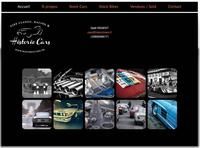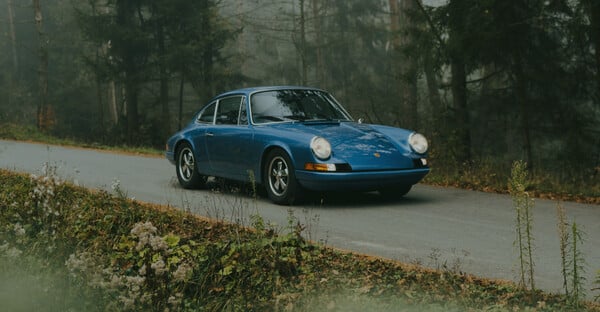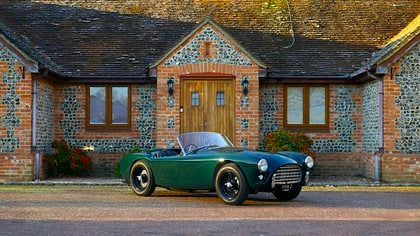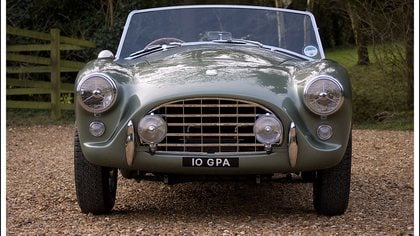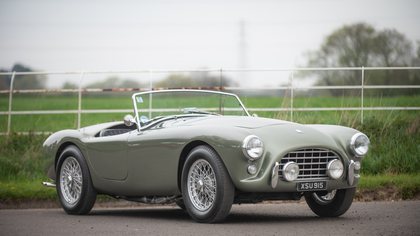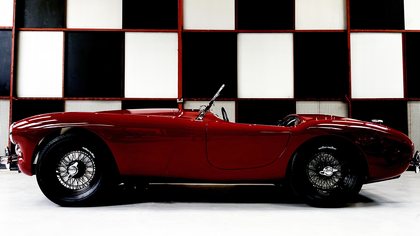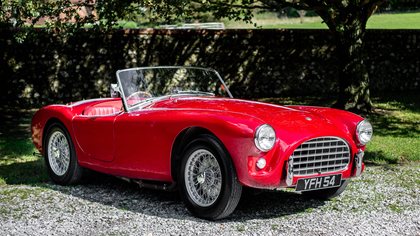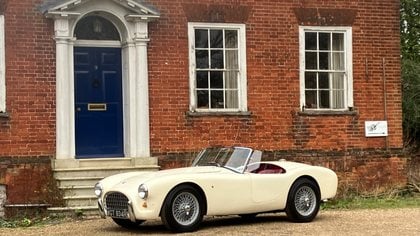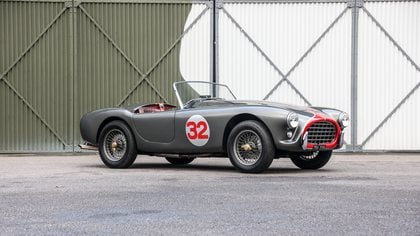Description
Before crossing the path of American Carroll Shelby, the AC Ace could have been a small roadster without great ambition, if not that of saving a moribund builder after the war. But the story of a creation as striking as the ancestor of the legendary Cobra could not be banal ...
Although widely known since the 1960s, AC is one of the oldest British automakers. But his story was not punctuated with success, far from it. Founded in 1901 by the Weller brothers and based in Ferry Works near London, AC presented its first "three wheeler" in 1903. The company was then called Autocars and Accessories and named its model the AutoCarrier. Two letters that will become an emblem since the company is renamed Auto Carrier in 1907. The craft, simple and practical, is a great success and AC moved in 1911 in a larger factory that the Weller have built in Thames Ditton near London. With its growing success, AC decided to market its first "4 wheels" in 1913. It is a small two-seater sports type. But interrupted by the First World War, production resumed in 1919 with the introduction of a new 1500 cm3 inline 6-cylinder engine designed by John Weller. In 1922, the name of the company became AC Cars Ltd. Heavily indebted, Weller sells shares of the company to the investor and pilot Selwyn Edge who undertakes to elevate AC to a recognized sports car manufacturer. For this, the 6-cylinder is developed in several competition. But sales decline and the crisis of 1929 puts the company to the carpet.
The brothers Charles and William Hurlock, owners of a transport company, bought it back in 1930 and production slowly resumed. Auto Carrier becomes AC Acedes Cars Ltd. Initially interested in the Thames Ditton buildings for their activities, the Hurlock brothers finally resigned themselves to continuing the sale of parts for the AC still outstanding which represent a significant potential market. Following an agreement with the Standard Group, a new line of cars is being developed for 1932. The Goodwood circuit designer Freddie March offers his services for the design of the new models that must reinforce AC as sports cars manufacturer. Gentlemen drivers are the privileged target of the company that is based on the saying "run on Sunday is sell on Monday"...
The Second World War again disrupts the life of AC which stops in 1940 and does not resume until 1947. The firm is limited to give a boost to seriously dated 2 liter models. Driver Cliff Davis buys the Tojeiro roadster and wants him to install a Bristol 6-cylinder engine under the hood. This requires reviewing the chassis but Tojeiro agrees. On the occasion of his first race at Goodwood, Cliff won. Successes ensued in the course of 1953 and Davis' car soon made a name for itself in the world of motor racing. It was then that driver and gentleman Vin Davidson ordered the same chassis from Tojeiro. At the same time, the Hurlock brothers on the lookout for a model that could revive AC on the sports ground decide to take an interest in Tojeiro's car.
Tojeiro also designed a chassis for Lionel Leonard and another for Vin Davinson. Through Ernie Bailey, Tojeiro met Derek Hurlock and his uncle Charles. It's also said that they were initially attracted by the example designed for Vin Davinson, but that this chassis was sold during the negotiations, and that they finally turned to the chassis designed for Davis Cliff. They'll just have to try out Davidson's car to be convinced of the validity of the idea..
The conceptual simplicity of the Tojeiro roadster fits in perfectly with the limited production facilities of AC Cars. The other interest is that at the end of an advantageous agreement it is expected that Tojeiro will be paid a royalties of £ 5 on each of the first 100 chassis sold, AC avoiding a significant investment while limiting the salary of his new employee! Based on the car purchased from Davidson, which became a consultant for AC, a first prototype was built very quickly for the 1954 London show. Instead of the 6-cylinder Bristol, the "6 Ditton" engine designed by John Weller before the war was installed. The new AC is called Ace.
Car well born, the AC Ace makes the happiness of its drivers, amateurs or professionals. After winning many victories in his class, Ken Rudd hires a car at the 1957 Le Mans 24H race. The endurance race must give the small AC roadster a significant media coverage around the world. But the Hurlock brothers, near their pennies, do not quite see the Sarthe race so well. Their plans are rather to revive the production of a sedan to develop the brand, Rudd resigns himself to finance his participation in the event. During 24H, the 6 inline Bristol proves once again its incredible reliability and the small AC ACE led by Ken Rudd and Peter Bolton finishes the race at an average speed of 157. 52 km/ h, which gives him a 10th place overall. The class victory scarcely escapes them, just behind the Ferrari 500 TR, but the top speed recorded in the Hunaudières at 209 km/ h impresses the crowd. Among them, a car racing enthusiast came especially from Texas to win the victory in 1959 remarks the English girl almost serial that runs in the middle of the big teams and ranks 7th in the race. AC cars will be present at Le Mans until 1962, during which they will find a worthy descent: AC Cobra ... Following Rudd's advice, Hurlock decided to offer an AC Ace version with the Bristol 2-liter engine for which it was originally designed. With 105 hp, it reached 200 km/ h. It was therefore aimed at the sportiest drivers. Some versions were later upgraded to 150 hp. In 1957, disc brakes were fitted. In April 1956, they became Ace Bristol and Aceca Bristol. Between 1956 and 1961, AC produced 463 roadsters and 172 coupes. However, Bristol was forced to suspend the supply of its engines in 1961. The Filton firm gave up producing its own engines, preferring to source V8s from the American Chrysler. The Hurlock brothers tried, without much success, to replace the 2-liter Bristol with the 2. 6-liter Ford Zephyr/ Zodiac. Five stages of preparation were offered, from 90 to 170 hp.
This overly commonplace package was not very exciting and, alas, never really delivered. Customers shunned these Ace and Aceca bastards. Surely, the ACs deserved a far more noble engine. The situation was critical, and it was time to bounce back. Jaguar had just presented its Type E at Geneva, with its undeniable charms, and sold at an unbeatable price. In the end, it was the United States that provided the miracle that would give birth to a new myth...
727 Ace models were produced, including 226 with AC engines (1953/ 1963), 463 with Bristol engines (1956/ 1963) and 38 with Ford engines (1961/ 1963). For the Aceca, there were 329 examples, with 152, 169 and 8 units respectively. From 1963 onwards, AC concentrated on the AC Cobra program.
Our AC Ace Bristol was delivered new on January 18, 1962 in Paris by the brand's French importer, Ets Chardonnet, to Alfred Morille of Parfums Raphae?l, who registered it under number 25 LW 75. He kept it for a year before selling it to E?tablissements Gauthier in Paris. Later sold to the Baroness d'Espin, it then went through only five owners, all of whom were identified, before the current owner purchased it in 2012. Born white with a red interior, it was the famous collector Jean-Paul Petit who undertook its mechanical restoration at C2C, as well as its bodywork at ODS between 2006 and 2011 in this superb navy blue hue. This original French car underwent several interventions by the garage RPM in 2012 and 2013 and more recently, the file includes an invoice from AS Classic Engineering (Alexandre Surber) dated July 2021 and totaling almost ?38, 000 of work on the mechanics and bodywork to make the car perfect. Front and rear axles completely rebuilt; clutch and transmission overhauled, as was the rear axle; front and rear brakes, etc...
These interventions reflect the concern of successive owners to use this car without worry, and its equipment bears witness to this. For example, it is fitted with a rack and pinion steering system instead of the original steering box, which makes the car devilishly efficient; an overdrive to lower engine speed on long-distance journeys; an oil cooler for efficient lubrication; an aluminum cooling radiator and a stainless-steel exhaust system. Eligible for all the major international rallies, including the Tour Auto, it was produced in very small numbers with its aluminum body and noble Bristol engine... This is a car to be enjoyed without moderation, and one that deserves a place in your collection.
